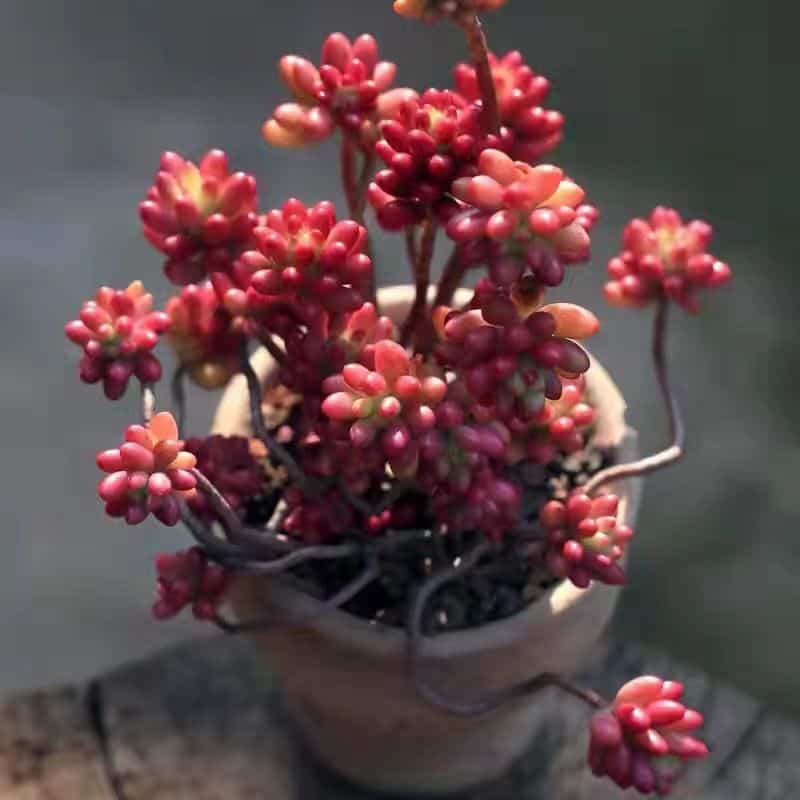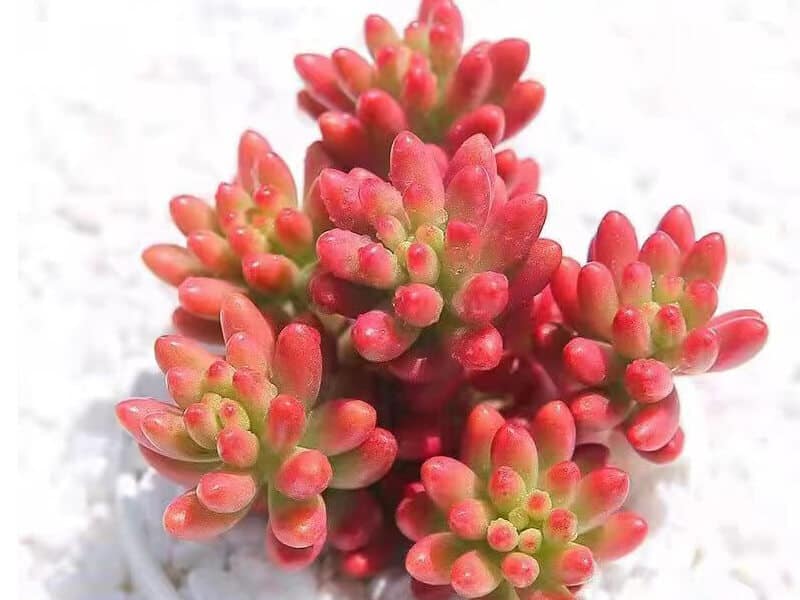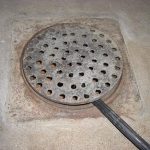Sedum Rubrotinctum ‘Roseum’, also known as the Jellybeans, comes from the Crassulaceae plant family. It is a succulent plant that originated in Mexico. This plant is pink in color, which gives it a unique and beautiful look.
A fascinating fact about this succulent is that it is very similar to the chameleon. By using the animal chameleon, It means that Sedum Rubrotinctum ‘Roseum’ can change its color throughout the different seasons; for example, it turns its leaves green when summers are around the corner.
Scientists have long believed that this change in color acts like a protective adaptation from the heat. When most plants are in their best state in spring, they sprout bright yellow flowers between the leaves.
Sedum Rubrotinctum ‘Roseum’ is a very small plant that grows up to 4 inches. It doesn’t require that much space too. It can be grown in a small pot.
Many people confuse Sedum Rubrotinctum ‘Roseum’ as whether it is an indoor plant or an outdoor plant. The answer to this Question is that Sedum Rubrotinctum ‘Roseum’ can be grown indoors and outdoors if they receive the required sunlight in both places.

Sedum Rubrotinctum Roseum Care
Most succulent lovers have at least one or two Sedum Rubrotinctum ‘Roseum’ in their collection; hence, the procedure for their growth must be known by the people who plan on growing them.
Like most succulents, the jellybean plant also does not require much effort in its growth and can easily adapt to the environment. Surprisingly, this plant requires no attention at all. Many plant owners have said that sometimes we forget this plant exists as we do not notice it at all.
The plant’s growing process has a few procedures necessary for the perfect growth of the plant.
Soil
The perfect soil mix for Sedum Rubrotinctum ‘Roseum’ is not so different than the soil requirement for other succulent plants. As most succulent plants require well-draining soil, the jellybean plant also flourishes in it. If wet soil is used, then it will cause the root to rot. Cactus mix with some perlite is the best combination of soil for the jellybean plant. When you’re about to plant the seed, you should first dig up a small hole in the soil and carefully place the seed in it. Afterward, fill the hole with more soil and gently press the surface. Then you’ll have to water it in an adequate amount.
Watering
The process of watering is dependent upon the weather conditions. As there isn’t any enigmatic formula or procedure, the watering of such kinds of succulents varies. You must water the plant weekly if your Sedum Rubrotinctum ‘Roseum’ is growing in an arid region. Moreover, in peak summers, when the sunlight directly points towards the plant, you will have to look after your plant frequently as water may dry up quickly.
Watering won’t be a big issue if you plan to grow Sedum Rubrotinctum ‘Roseum’ in a humid region. In humid regions, water is not dried up quickly. Hence it would be best to look after your plant every two weeks and water it only when you feel it is necessary.
When winters are around the corner, you should keep your plant indoors so that your plant is safe from frostbite.
Sunlight
Sedum Rubrotinctum ‘Roseum’ needs plenty of bright sunlight but not full sun. The best area for such plants is where partial or filtered sunlight is available. If the plant is exposed to full sunlight, it might cause sunburn and ruin the plant as it will lose its color.
If one plans to keep the plant indoors, they’ll have to provide their plant with some light or keep it under the sun so that their sunlight needs are fulfilled.
Fertilizer
Succulents don’t require certain fertilizers and can be grown without nourishment. During the early days, Sedum Rubrotinctum Roseum didn’t require fertilizers and should be left on its own. Fertilizers should only be used in early spring when plants are eager to grow. The perfect amount of dosage of fertilizer is also quite important. For Sedum Rubrotinctum Roseum, ¼ to ½ should be used depending on the strength of the fertilizer.

Propagation
Most of the succulents easily propagate from leaf or stem cuttings. They can root easily; sometimes, leaves fall off easily on the ground and grow a plant. One should stick the leaf back into the pot so that it can grow. Sometimes people take stem cuttings to propagate and grow in different containers.
Pests Diseases
You might have heard that different kinds of pests always hunt down plants. Sedum Rubrotinctum ‘Roseum’ also has some enemies. Snails, slugs, and caterpillars find this plant amusing and usually hunt the plant down. One should use different drugs to kill such creatures to eliminate this problem.
Conclusion
At first, it may feel like growing such kinds of succulents is difficult, but when you get the hang of it, all succulents, including Sedum Rubrotinctum Roseum, are quite easy to grow and care for. You can successfully grow a healthy plant by keeping the pointers mentioned above in mind. Hope you enjoy growing this plant!




